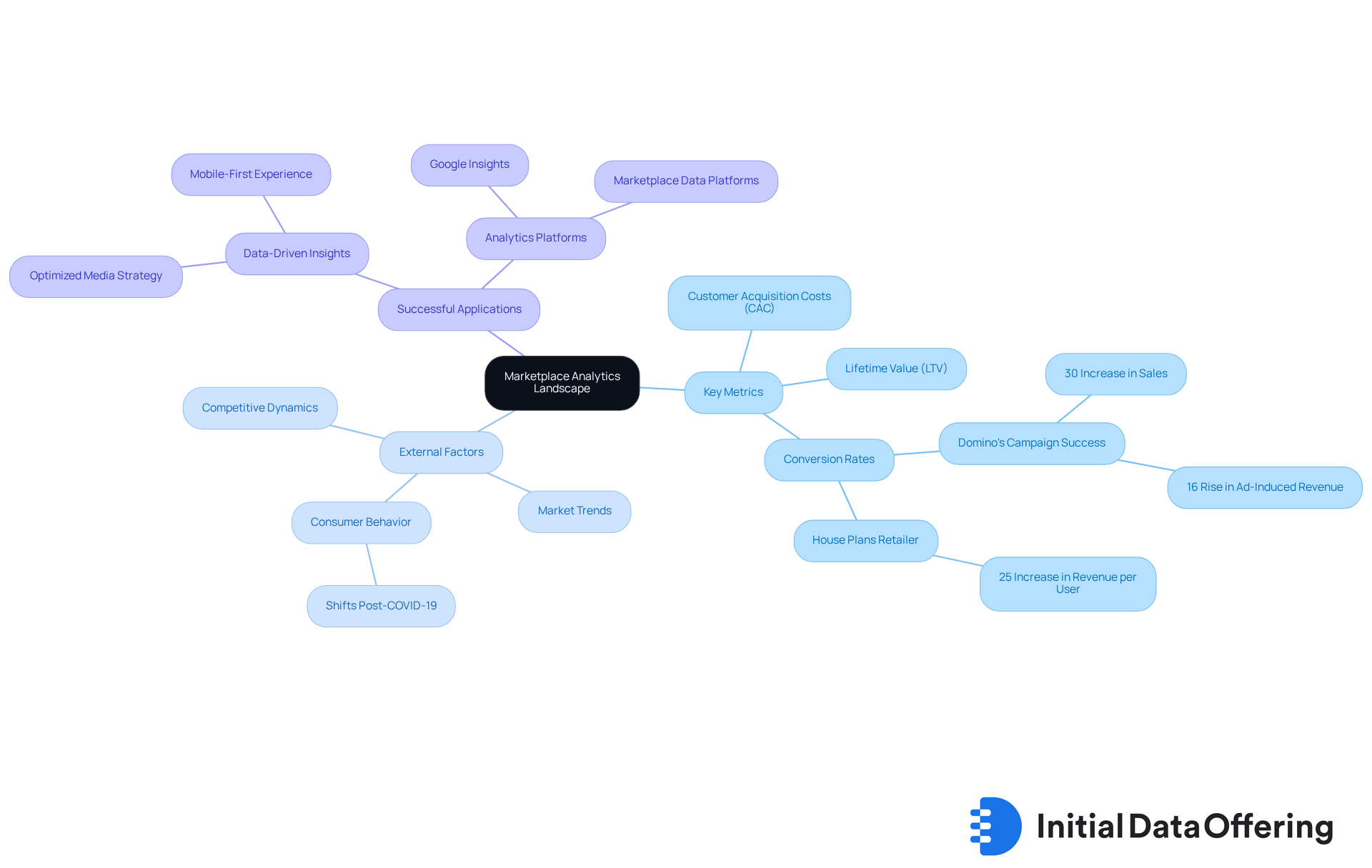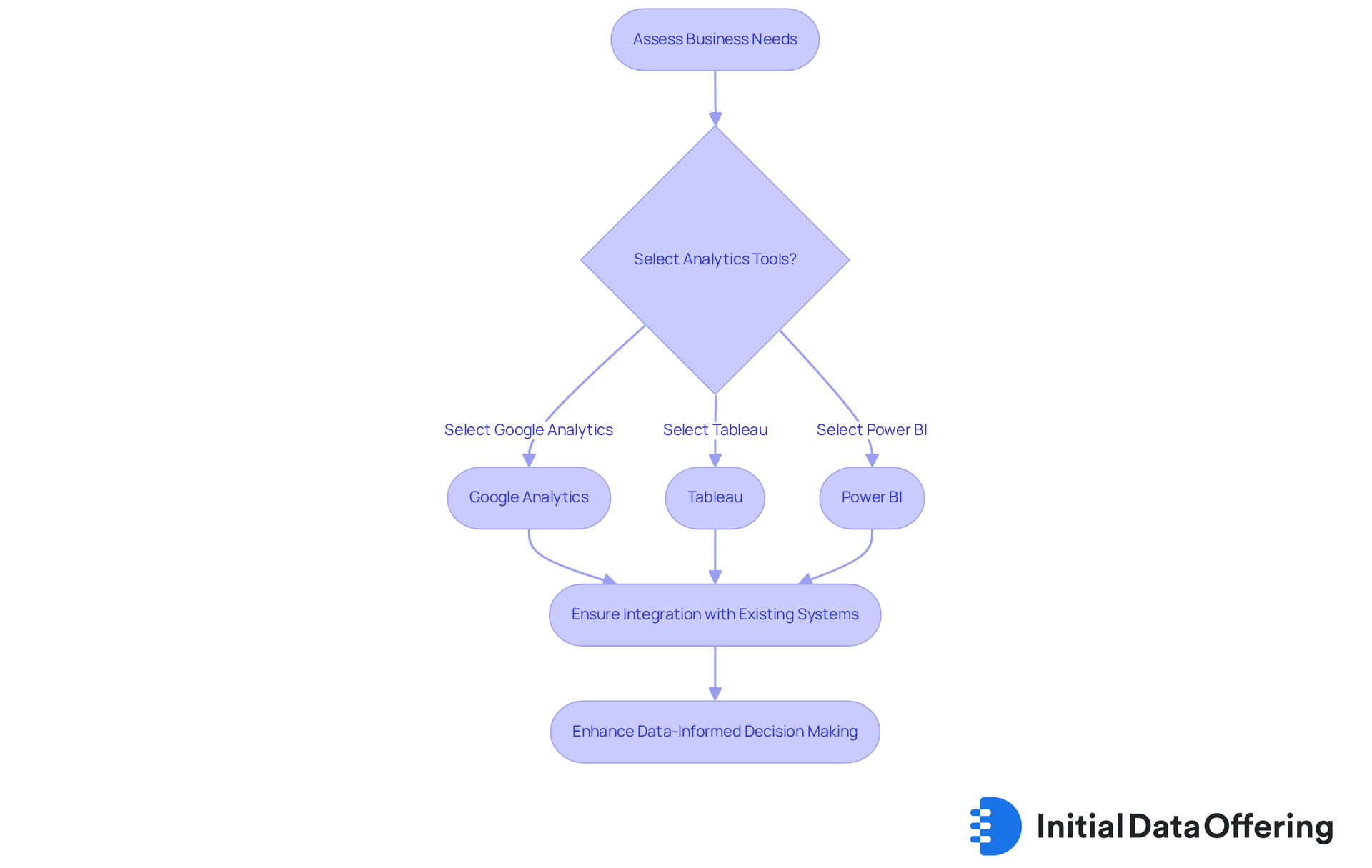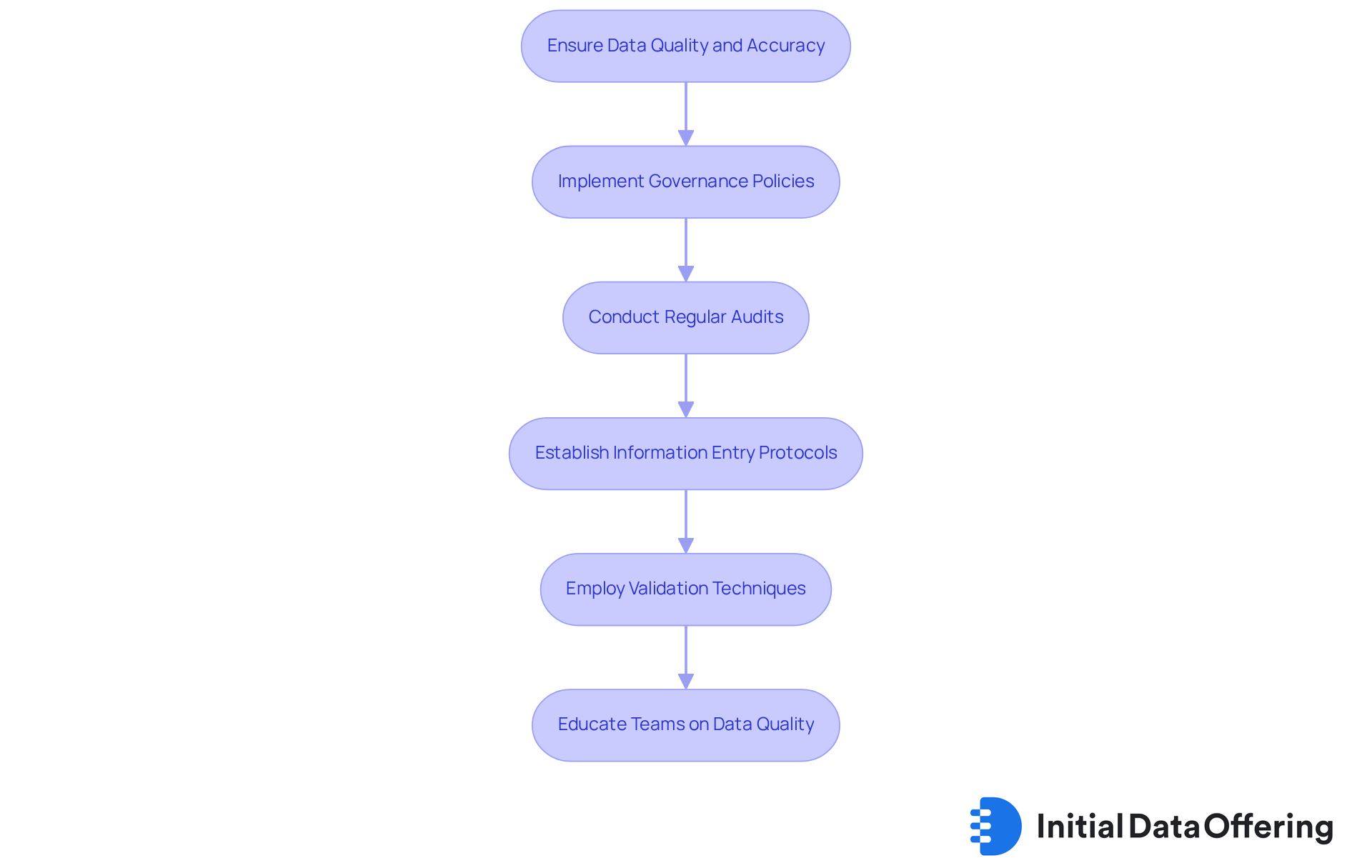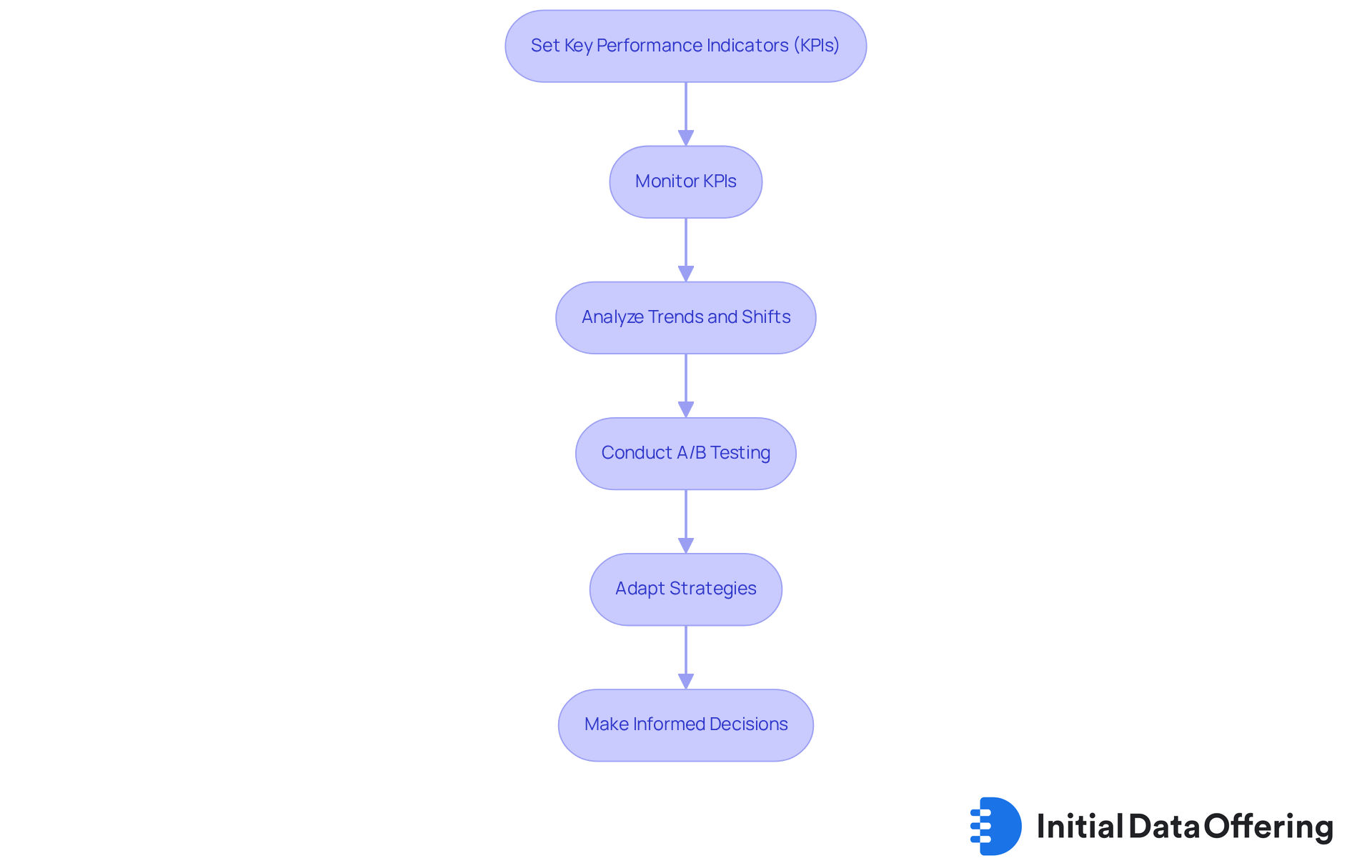Mastering Marketplace Analytics: Key Practices for Success

Mastering Marketplace Analytics: Key Practices for Success
Overview
Mastering marketplace analytics encompasses several critical components:
- Understanding key performance metrics
- Selecting and integrating appropriate tools
- Ensuring data quality
- Regularly adapting strategies to sustain a competitive edge
These features collectively provide businesses with the advantage of informed decision-making. By leveraging accurate analytics, organizations can drive growth and enhance their overall performance. The article illustrates this by presenting examples of successful data-driven initiatives, underscoring the benefits of utilizing marketplace analytics to remain agile in a dynamic environment.
How can your organization implement these insights to improve its own analytics strategies?
Introduction
Navigating the intricate world of marketplace analytics can seem daunting; however, it is crucial for unlocking significant growth and gaining a competitive advantage. By mastering essential practices such as:
- Understanding key metrics
- Selecting appropriate tools
- Ensuring data quality
organizations can transform insights into actionable strategies. This mastery not only enhances operational efficiency but also empowers businesses to make informed decisions that drive success. Yet, with the rapid evolution of consumer behavior and technology, companies face a pressing challenge: how can they continuously adapt their analytics strategies to not only keep pace but also lead in their respective markets? This question invites reflection on the dynamic nature of analytics and its critical role in shaping business outcomes.
Understand the Marketplace Analytics Landscape
To effectively navigate the marketplace analytics landscape, organizations must first comprehend the various elements that affect their performance. Recognizing key metrics such as customer acquisition costs (CAC), lifetime value (LTV), and conversion rates is essential. Additionally, companies should be aware of external factors like market trends, consumer behavior shifts, and competitive dynamics. By synthesizing this information, organizations can develop a comprehensive view of their marketplace position, enabling them to identify opportunities for growth and areas needing improvement. For instance, a campaign for Domino's achieved a remarkable 30% increase in sales by leveraging data-driven insights to optimize their media strategy. This showcases the significant impact of understanding consumer behavior.
Furthermore, utilizing resources such as Google Insights or dedicated marketplace data platforms can offer a greater understanding of user behavior and preferences. This enables companies to customize their offerings accordingly. A leading house plans retailer, for example, experienced a 25% increase in revenue per user after implementing a mobile-first welcome experience that communicated value propositions clearly. This example demonstrates how data marketplaces and analysis platforms can enhance user engagement and drive revenue growth.
Grasping these dynamics is essential for mastering marketplace analytics and driving informed strategic decision-making. Ultimately, this results in sustainable growth and improved business performance. How can your organization leverage these insights to enhance its market position?

Select and Integrate the Right Analytics Tools
Choosing the appropriate resources for analytics is a vital step in mastering marketplace analytics. Businesses should assess their specific needs and objectives before selecting resources that align with their goals. Popular choices include:
- Google Analytics for web traffic analysis
- Tableau for visualization
- Power BI for intelligence reporting
Each tool offers distinct features that can enhance analytical capabilities.
Integration is equally significant; organizations must ensure that their selected tools can seamlessly connect with existing systems, such as CRM platforms or e-commerce solutions. This integration allows for a holistic view of data across different channels, facilitating more accurate insights. For instance, integrating Google Analytics with an e-commerce platform can reveal customer behavior insights, enabling businesses to optimize their sales funnels and improve conversion rates. Statistics indicate that companies employing integrated data analysis resources can experience a notable increase in operational effectiveness and decision-making precision, with predictive analysis potentially enhancing efficiency by 20%.
Furthermore, companies should consider investing in advanced analytics solutions that incorporate machine learning and predictive analytics. These tools can assist in forecasting trends and consumer behavior, allowing companies to stay ahead of the competition. As Neil Patel emphasizes, precise information can significantly influence sales, making it essential for e-commerce stores to utilize resources like Google Analytics effectively. By thoughtfully choosing and integrating the right data analysis tools, organizations can significantly enhance their data-informed decision-making processes, ultimately leading to improved results through marketplace analytics.

Ensure Data Quality and Accuracy
Ensuring the quality and accuracy of information is crucial for effective marketplace analytics. Businesses should implement strong governance policies that outline standards for information entry, validation, and maintenance. Regular audits and information cleansing processes can help identify and rectify inaccuracies, ensuring that the information used for analysis is reliable.
One effective approach is to establish clear information entry protocols that minimize human error. For example, utilizing dropdown menus or predefined formats assists in standardizing information input, thereby minimizing inconsistencies. Moreover, employing validation techniques, such as cross-referencing information against recognized sources, can further improve accuracy.
Furthermore, organizations ought to invest in educating their teams on the significance of information quality and the tools accessible for preserving it. By fostering a culture of information integrity, companies can ensure that their marketplace analytics efforts yield actionable insights. For instance, a retail firm that emphasizes information quality can gain clearer insights into customer preferences, resulting in more efficient marketing strategies and enhanced sales performance. This commitment to data governance not only enhances operational efficiency but also drives better decision-making across the organization.

Monitor and Adapt Analytics Strategies Regularly
To sustain a competitive advantage, companies must consistently observe and adjust their data strategies using marketplace analytics. This process begins with setting key performance indicators (KPIs) that align with overarching organizational objectives, followed by careful monitoring of these metrics. By analyzing KPIs, organizations can uncover trends and shifts in consumer behavior, enabling timely adjustments to their strategies. Studies indicate that companies forfeit around $5.2 million in income due to unutilized information, underscoring the financial consequences of poor analytical methods.
For instance, a marketplace experiencing a decline in customer engagement may need to reevaluate its marketing tactics or product offerings. Conducting A/B testing can provide essential insights into customer preferences, enabling businesses to enhance their methods based on real-time information. Research shows that A/B testing can significantly improve customer engagement, with effective tests leading to heightened conversion rates and user satisfaction.
Moreover, organizations should remain vigilant to new data trends and technologies. Engaging in industry conferences, webinars, and subscribing to relevant publications can yield valuable insights into the latest developments. As Hilary Mason states, "At the core of data examination and data science is curiosity and learning; finding patterns, telling stories, and deepening your understanding of the world around you." By staying informed, companies can leverage innovative tools and methods to enhance their data analysis capabilities. Ultimately, a proactive approach to monitoring and adapting data strategies empowers organizations to make informed decisions that drive growth and success. Furthermore, with a 36% increase in demand for information specialists, the significance of efficient analysis strategies is more essential than ever. A case study on 'Customer Experience Personalization' illustrates how marketplace analytics aids businesses in analyzing customer interactions and preferences instantly, leading to tailored solutions that enhance customer satisfaction and loyalty.

Conclusion
Mastering marketplace analytics is pivotal for organizations seeking to enhance their competitive edge and drive sustainable growth. Understanding the analytics landscape and selecting the right tools are essential features that empower businesses. By ensuring data quality and regularly adapting strategies, organizations can transform raw data into actionable insights that inform decision-making and optimize performance.
Key practices highlighted include:
- Identifying relevant metrics
- Integrating analytics tools with existing systems
The advantage of maintaining high data quality through governance and training cannot be overstated. Additionally, the need for continuous monitoring and adaptation of analytics strategies allows organizations to remain agile and responsive to market dynamics and shifts in consumer behavior. How can your organization benefit from embracing these practices?
Ultimately, embracing these best practices in marketplace analytics not only improves operational efficiency but also fosters a culture of data-driven decision-making. Organizations are encouraged to harness these insights to refine their strategies, enhance customer experiences, and secure a stronger market position. The future of marketplace success hinges on the ability to leverage analytics effectively—an investment that promises significant returns in an increasingly data-centric business environment.
Frequently Asked Questions
What are the key metrics organizations should understand in marketplace analytics?
Organizations should understand key metrics such as customer acquisition costs (CAC), lifetime value (LTV), and conversion rates.
Why is it important to recognize external factors in marketplace analytics?
Recognizing external factors like market trends, consumer behavior shifts, and competitive dynamics is essential for developing a comprehensive view of an organization's marketplace position and identifying growth opportunities.
Can you provide an example of how data-driven insights can impact sales?
Yes, a campaign for Domino's achieved a 30% increase in sales by leveraging data-driven insights to optimize their media strategy, demonstrating the significant impact of understanding consumer behavior.
What resources can organizations use to gain insights into user behavior?
Organizations can use resources such as Google Insights or dedicated marketplace data platforms to gain a better understanding of user behavior and preferences.
How can customizing offerings based on data insights affect revenue?
For example, a leading house plans retailer experienced a 25% increase in revenue per user after implementing a mobile-first welcome experience that clearly communicated value propositions, showcasing how data insights can enhance user engagement and drive revenue growth.
What is the ultimate goal of mastering marketplace analytics?
The ultimate goal of mastering marketplace analytics is to drive informed strategic decision-making, resulting in sustainable growth and improved business performance.